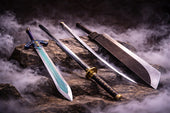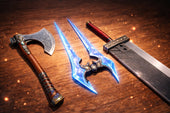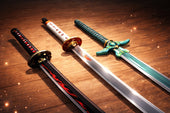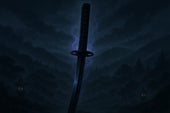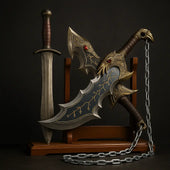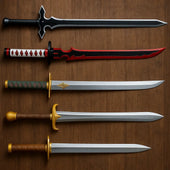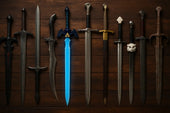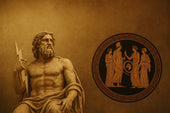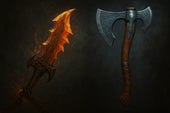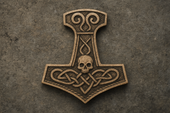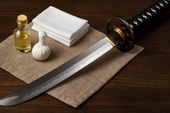As a lifelong fan of the God of War series, we can’t help but be captivated by the incredible array of weapons wielded by our fierce protagonist, Kratos. Seriously, who doesn’t feel a rush of adrenaline when you hear the swish of the Blades of Chaos or the thud of the Leviathan Axe? These tools of destruction have become as much a part of Kratos' identity as the character himself! In this blog post, we'll dive deep into the rich history and significance of Kratos' most legendary weapons, exploring how they've evolved and shaped both gameplay and storytelling in the God of War franchise.
The Blades of Chaos
At the heart of Kratos' arsenal lies the Blades of Chaos—those iconic chained, sickle-like blades that have been with the Ghost of Sparta since the very beginning. Forged in the fiery depths of the Underworld, these bad boys were a gift from Ares, Kratos' former mentor and the god of war. Talk about a complicated relationship! The Blades of Chaos embody Kratos' dark past as a servant of the Olympian gods—a chapter in his life that ultimately led to his downfall and the annihilation of the Greek pantheon.
These blades aren't just a weapon; they’re an extension of Kratos' rage and determination. The design, with the blades chained to his forearms, symbolises the inner turmoil he grapples with daily. It’s like a constant reminder of his struggle to control those destructive impulses. Throughout the earlier God of War games, the blades were Kratos' go-to for dispatching enemies, their swift and brutal attacks perfectly mirroring his unyielding nature.
As the series progressed, the Blades of Chaos underwent subtle changes, reflecting Kratos' evolution as a character. In God of War III, the blades were supercharged with the power of the gods, granting Kratos even greater destructive capabilities. This transformation not only boosted gameplay but also visually represented Kratos' growing mastery over the powers of the Olympian deities.
The Leviathan Axe
When Kratos embarked on his epic journey to the Norse realms in the 2018 God of War, he found himself wielding a brand-new weapon: the Leviathan Axe. Crafted by the dwarven blacksmiths Brok and Sindri, this axe was a significant departure from the Blades of Chaos in both design and functionality.
Unlike the chained blades, the Leviathan Axe is a one-handed weapon that beautifully reflects Kratos' newfound role as a father and protector. Its Norse-inspired aesthetic is a nod to Kratos' transition from the Greek pantheon to the rich tapestry of Norse mythology. Plus, who doesn’t love the thrill of throwing the axe and calling it back? That mechanic added a new layer of strategy and versatility to Kratos' combat style!
But the Leviathan Axe isn’t just a powerful weapon; it embodies Kratos' personal growth and his evolving relationship with his son, Atreus. Its ability to serve as both a weapon and a tool for puzzle-solving showcases Kratos' role as a teacher and guide, imparting his hard-earned wisdom to the next generation. The axe's symbolic connection to Yggdrasil, the World Tree of Norse mythology, further reinforces Kratos' journey toward redemption and restoring balance in the world.
Other Notable Weapons
While the Blades of Chaos and the Leviathan Axe may steal the spotlight, the God of War series has introduced an impressive arsenal of other legendary weapons. Take the Blade of Olympus, for instance—a powerful sword forged by the gods themselves, capable of slaying even the mightiest deities. Or the Nemean Cestus, a pair of gauntlets that allow Kratos to unleash devastating close-range attacks. The Blades of Athena, a variant of the Blades of Chaos, highlight Kratos' brief alliance with the goddess of wisdom and war.
Each of these weapons serves a practical purpose in combat while carrying significant symbolic weight. The Guardian Shield, for example, emphasises Kratos' newfound role as a father, allowing him to protect both himself and Atreus.
The Impact of Weapons on Gameplay
The diverse array of weapons in the God of War series profoundly impacts gameplay, shaping how players approach combat and exploration. Each weapon comes with its unique set of abilities, strengths, and weaknesses, making it essential for players to adapt their strategies accordingly.
The Blades of Chaos excel at crowd control and rapid, acrobatic attacks, while the Leviathan Axe shines in powerful, single-target strikes and ranged combat. The ability to switch between these weapons and unlock new abilities has empowered players to tailor their combat approach to their preferences and the challenges they face.
Beyond combat, Kratos' weapons are vital for puzzle-solving and exploration. The Leviathan Axe's throw-and-recall ability is perfect for activating mechanisms, moving heavy objects, and accessing previously unreachable areas. This integration of weapon mechanics into the game’s puzzles and traversal challenges creates a seamless and immersive experience, where mastering Kratos' arsenal is just as crucial as honing reflexes and problem-solving skills.
Weapons as Storytelling Devices
In the God of War series, Kratos' weapons serve not just as gameplay tools but also as powerful storytelling devices, reflecting his personal growth and the overarching themes of the franchise.
The Blades of Chaos constantly remind us of Kratos' past as a servant of the Olympian gods, a dark chapter that haunts him throughout his journey. Their evolution, from their initial form to their empowered state in God of War III, mirrors Kratos' struggle to come to terms with his past and find a path toward redemption.
Conversely, the Leviathan Axe in the 2018 God of War marks a significant shift in Kratos' character arc. The axe’s connection to Norse mythology and its role in Kratos' relationship with Atreus symbolise his transformation from a rage-fuelled warrior to a more contemplative, protective father. Its dual purpose as both weapon and tool further reinforces this idea of Kratos' growth and his desire to impart wisdom to the next generation.
Moreover, the overall collection of weapons connects the different mythological realms Kratos traverses. The Blade of Olympus not only represents his power as the Ghost of Sparta but also serves as a bridge between Greek and Norse mythologies, foreshadowing his journey to the northern realms.
The Iconic Status of Kratos' Weapons
Kratos' weapons have become so iconic that they've transcended the God of War franchise, becoming part of gaming culture and popular culture at large. From action figures and collectibles to fan art and cosplay, his arsenal symbolises the character's enduring legacy and the impact of the God of War series on the gaming industry.
The Blades of Chaos are among the most recognisable weapons in gaming history, with their distinctive design and brutal attacks leaving a lasting impression on players. Meanwhile, the Leviathan Axe has quickly gained a following, its Norse-inspired aesthetics and powerful frost abilities captivating gamers around the world.
The popularity of these weapons has fostered a thriving community of fans who dedicate hours to mastering Kratos' combat style and exploring the deeper meanings behind his arsenal. From speedrunners perfecting the use of the Blades of Chaos to cosplayers meticulously recreating the Leviathan Axe, the legacy of Kratos' weapons is a testament to the God of War series' lasting impact.
Kratos' iconic weapons have been fundamental to the God of War franchise since day one, serving as both powerful gameplay tools and compelling storytelling devices. From the Blades of Chaos, which have been with him since the start, to the Leviathan Axe, a symbol of his personal growth, these armaments have left an indelible mark on the gaming industry and fans alike.
As the God of War series continues to evolve and explore new mythological realms, I can’t wait to see what new and equally iconic weapons Kratos will wield. Whether it’s a return of the Blades of Chaos or entirely new armaments, one thing is clear: Kratos' weapons will remain integral to the franchise's enduring legacy, shaping gameplay, storytelling, and cultural impact for years to come!




